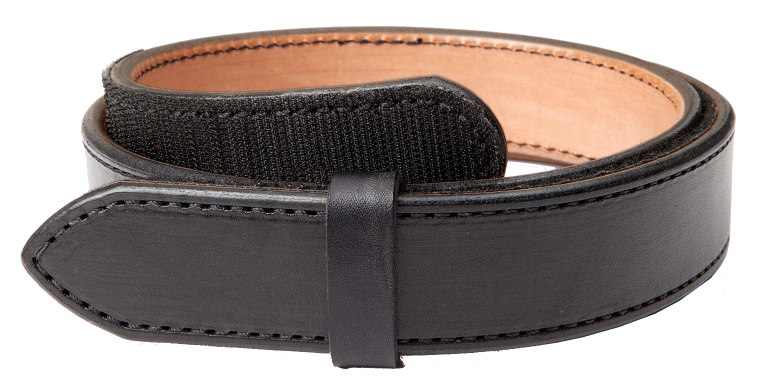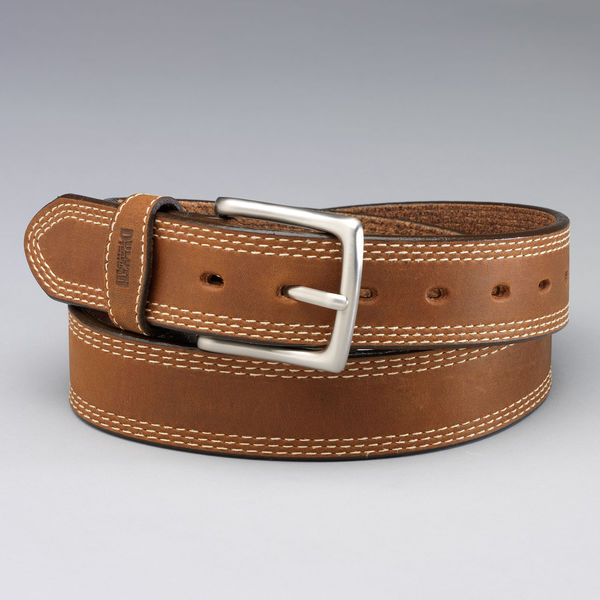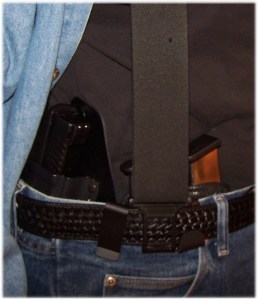Keeping Everything Up Tight and Out of Sight

WHAT KIND OF GUN BELT SHOULD YOU GET?
One of the important factors of IWB carry is the belt being used to do so. While I have my favorite type of belt, which I will bring out later, most folks that have drunk the gun belt cool-aid would probably recommend a metal-reinforced belt that is specifically made to carry a holstered firearm OWB (Outside the Waist Band) or OTB (On The Belt).
A gun belt for IWB carry does not need to be as ‘reinforced as that for OWB or OTB. The holster is inside the pant and the belt simply cinches the holster tight against the body. The holster is normally attached by straps or clips that also serve to stabilize the holster .
Back in the days of the “Real Old West” gun belts and holsters were as wide and varied as the people who carried firearms. A pistol (a revolver was called a pistol back then) might be carried in a sash, stuffed into the trousers, or if the bearer of a firearm was lucky enough, they might even have a holster.
“The first gun belts—waist belts, with a holster and fitted loops to pack extra cartridges—were inspired by the introduction of big-bore ammunition—cartridges .41 caliber and up,” Firearms Editor Phil Spangenberger says.
Gun belts were usually separate from belts that held up the trouser. Prior to Sam Colt’s 1830s development of the first dependable cap-and-ball revolver, the smaller single-shot flintlock and cap-and-ball pistols were usually stuck into a coat, vest or pants pocket, or the larger pistols were stuck into the waistband of the pants.

At first, holsters were worn on any type of belt. And even in the early days of the Mexican Loop holster, the style and design of a belt seldom matched the holster. It wasn’t until after the Civil War when cartridge revolvers began to replace cap-and-ball pistols that saddle makers began to sew cartridge loops onto the sides of the belts for the gun-wearer to carry extra cartridges where they were easy to get to, and the authentic “gun leather rig” of the shoot-’em-up days of the Old West was finally born.
Somewhere along the line, somebody figured out that a holster could be hung from a pant’s belt and that it was a good idea to do so. Somewhere I read that belts probably did not turn up until the 1920s when the waistlines on men’s pants began to go south and belts became both necessary and fashionable. I; however, discount that statement as there are plenty of photographs and drawings showing the use of the belt to hold up one’s trousers well before the 1920s.
Belts have been around for a long time, and holsters even longer.
The bane of the belt is the same bane that plagues most of us – sag. Over time the belt will give way to being worn. Add the weight of a holster and holstered firearm, and the chances are that it will give out sooner than later. With that said, carrying IWB as compared to OWB is a bit more forgiving on a belt. There is another ’sag’ to concern ourselves with; that of the trousers sagging on the carry side, which obviously conveys the fact that we are carrying something heavy on that side (depending on the firearm being carried, of course). I’ll get into how to counteract that later.
With OWB, the holster is outside the pants and held in place by the belt and belt loops. With IWB carry, the holster is carried inside the trousers and held in place not only by the belt, but also with the waistband of the trousers. A belt can be somewhat stretched and still be adequate to hold an IWB holstered firearm securely in place. The pictured gun belt on the title page is a Heavy-Duty Gun Belt made by Urban Carry. The belt is made with “Heavy-Duty 1/4” Thick Bull Hide.”
Listing all the manufactures of gun belts would fill pages and is beyond the scope of this article. What is important is to know what to look for in a good gun belt for IWB carry and what is not necessary.
We could pretty much separate gun belts for IWB carry into two classes; dress and working.
A dress belt may be about 1 1/4-inch wide or even slimmer. When wearing dress slacks, you may be limited on the type and size of pistol you can carry; carrying a Glock G17 may not work out well but carrying a Glock G26 or G43 just might. You just might opt to carry a small semi-automatic pistol or revolver in a pants pocket (with suitable holster, of course) rather than on the belt. Regardless, the belt needs to be enough to keep the pants up while you carry your PDA (Personal Defense Assistant). In most cases where I absolutely must wear suit and tie, I look to other concealed carry alternatives for carrying a small pistol (or revolver) discreetly.
Getting into the leisure/work category of belt and the field expands immensely. Most work jeans and leisure slacks will handle a 1.5-inch belt and the gun belt world is your oyster.
One thing that I look for is adjustability. Most belts have 5 holes for securing the belt. More is better. There is also the spacing. I have worn belts where one notch can make the difference between being too tight and too loose.
The example that follows is from Hanks Belts. It is steel reinforced (Tri Layer: Leather + Steel + Leather), is as classy as it is functional, and is warranted for – wait for it – 100 years. It is available in black and brown.

Crossbreed Holsters also has a line of gun belts, one of which is the Crossover line. The slide buckle design means no holes are needed in the leather, which gives a large range of size adjustment. A good selection of buckles is available. The belt is available in black or brown.

The belt is not reinforced. As Crossbreed puts it, “Because we use the best leather, there is no need for a stiffening insert. Each belt is then hand beveled, hand burnished, hand edge dyed, and then recessed stitched with Fil-Tec premium nylon 277 thread. The belts will be approximately ¼” thick resulting in a strong belt with superior support for carry while still offering the flexibility for comfortable every day wear.”
To keep this article as short as possible, let me quickly introduce my favorite belt for everyday IWB carry – the “Dutyman 1.5-inch Buckleless Inner Belt.”


I discovered these belts back when I was a LEO. They are intended to secure a gun belt. The belt is turned over to reveal a Velcro liner, which secures a Velcro-lined duty belt when the two are paired together. Turn the belt over to its finished side and you have a daily wear belt.
I have worked around cars, trucks, and motorcycles most of my life and I really like the fact that these belts have no buckle to scratch fenders and such, and they can be adjusted as tight or as loose as needed. I prefer the basket weave belt, as it hides scrapes from holster clips better than the plain model, but both have been effective for IWB carry; they have both supported a full-size Government model 1911, holster, and double mag pouch for several years.
Dutyman also carries the above without the liner and are also available in black or brown. These belts are very reasonable in cost.
Another belt along these lines are from Crossbreed Holsters and is the Instructor Gun Belt with Velcro® Brand Closure, which is shown on the next page.
According to Crossbreed Holsters; “The CrossBreed® Instructor Belt with Hook & Loop Closure has a buckle-less design which boasts comfort, a sharp and professional appearance and the utmost stability and comfort. As with all belts by CrossBreed®, this belt is made utilizing top grain cowhide and lined with premium leather with stitched cross grain creating a strong sturdy carry belt. Each belt has recessed stitching and is hand buffed, burnished, and treated. The belts will be approximately ¼” thick resulting in a strong belt with superior support for your carry needs, while still offering flexibility for comfortable every day wear.”

These are the ‘must have’ requirements for an IWB gun belt:
- A 1 ½-inch (dress) gun belt. A gun belt that is 2 inches longer than you would normally wear. This will give you the option of carrying IWB/OWB.
- A gun belt with a 7 hole rather than a standard 5-hole tongue. (Same reason as above.)
If you go with one of the thinner, (dress) leather gun belts then you want a POLYMER REINFORCED internal belt liner. Not to worry, though! A thinner reinforced gun belt can be very strong.
If you go with a tactical web or fabric gun belt, then double-thick fabric should be enough; and a polymer liner inside this type of gun belt is going to be too rigid (and uncomfortable) for many people to wear all day long.
If you go with a heavy leather gun belt (a la, ‘William Tucker’) you are not going to need any kind of reinforcement. This sort of top-quality gun leather stands up to considerable weight and wear very well on its own. (Again, I really like mine!)
Any of these different types of gun belts will suffice and go a long way towards preventing your pistol from sagging or, ‘patterning’ and giving away the fact that you are armed.
Additional Support
Even the best gun belt may not fully keep the pants up on the gun side. You may need some assistance, and for me that means a set of suspenders. My favorites are from Perry, simply because they support the belt that in turn is supported by the belt loops.
For me, carrying a full-size Government Model 1911, or even a Glock G45 or Springfield Armory XDm 5.25 is burdensome on the body and the suspenders help bear and distribute the load.
The above set is an example of the Perry Dress suspenders. I also have several Ruf-N-Tuf suspenders, camouflage, and novelty suspenders.
What I Don’t Recommend
I do not recommend web or nylon belts unless they are properly reinforced. To ensure not only a proper carry, but also to ensure no interference pulling your PDA from its holster, a solid platform is needed, and non-reinforced web or nylon belts just don’t provide that.
Other Resources

5 Best Gun Belts for Concealed Carry & Range [2019] : https://www.pewpewtactical.com/best-gun-belts-concealed-carry-range/
![]()




3 Responses to Belts for IWB Carry